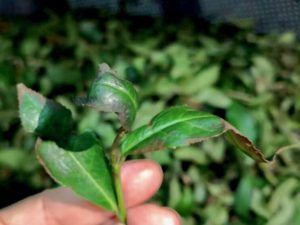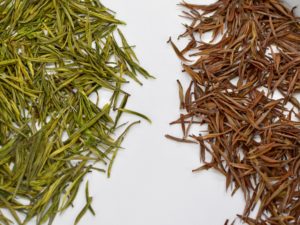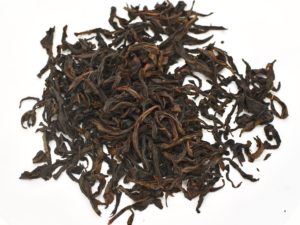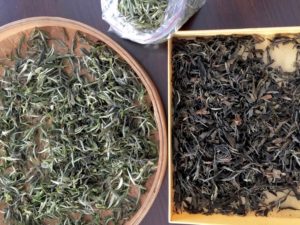Though somewhat counterintuitive, aged tea is in fact a recent phenomenon. Before the 21st century, fresh tea was always considered to be the best. However, while it is true that freshly made teas tend to have the strongest and brightest aromas, many types of tea develop fascinating new flavors and textures with time. Tea that has been aged to develop these characteristics is often referred to as chen cha (陈茶) or “aged tea.” Many tea drinkers in the past few decades have come to enjoy and even prefer these aged characteristics, and the newfound market for aged teas reflects this trend.
While sheng and shu puer receive most of the attention among aged teas, they are not the only types of tea that can age well. Most teas will keep well for many years if stored properly, and many drinkers even prefer the mellower taste of teas aged anywhere from a few months to several years. In particular, white tea and dark wulong teas like Wuyi rock wulongs and Dan Cong wulongs are capable of developing beautiful aged characters. The sometimes striking development of aged puer’s rich and complex flavor is a unique case that deserves its own later blog post. Today, we’ll explore some other under-appreciated types of aged tea.
How does aged tea change?
Gradual oxidation is one of the main changes that occur as tea leaves age. Oxidation is a natural chemical process that begins as soon as the tea leaves are plucked from the bush. Processing fresh teas often involves stopping, accelerating, or halting the oxidation process midway at the desired point. When tea becomes more oxidized, its leaves and brew tend to turn darker in color. Green teas, which are minimally oxidized, are much lighter in color of both leaf and infusion than dark teas like black tea, which are almost completely oxidized.

Tea’s nutritional composition changes with oxidation as well. As oxidation occurs, more and more of the antioxidant compounds found in tea will naturally combine into new, larger molecules. This results in new, different antioxidants, and while nothing is actually added or lost from the tea, the levels and types of nutrients present do change.
Exposure to greater moisture, light, air, and warmth will all encourage further oxidation of finished teas. This is especially noticeable in lighter teas like greens, yellows, and Anxi style wulong teas, which are minimally oxidized in the first place. Darker teas like black tea and dark wulong have less room to change because they are already quite oxidized once they have gone through processing.
Change in aroma is typically the first noticeable difference that appears in aged tea. Aromas fade quickest out of all of fresh tea’s characteristics, mellowing and eventually fading out over the years. However, age can sometimes impart new subtleties or complexities to the changing aroma as the brightest notes fade, revealing other layers underneath.
In general, the better quality fresh tea you start with, the better quality aged tea will result. The aging process cannot turn poor quality tea into high-end specialty tea. Aging can give the smoky roastiness of freshly roasted wulong, the earthiness of shu puer, or the astringency of young sheng puer time to soften into something that many find more palatable. However, in the end, it can only develop the character that is already present. Furthermore, there is some level of risk in aging tea. Without maintaining favorable conditions, tea can spoil or easily degrade in quality. Tea leaves are particularly prone to absorbing aromas from their surroundings, so it is important to keep them away from any strong or unpleasant smells while they rest.
The Light Teas: Green, Yellow, and Anxi Wulong
The lighter, less oxidized teas like greens, yellows, and Anxi wulongs show perhaps the least desirable changes when aged. Time tends to wear away the “fresher” characteristics that are so highly prized for these types of tea. However, even short-lived green teas are reasonably shelf stable for at least 18 months if dried properly during processing to a moisture content of 6-7%.

The oxidation process reveals itself most visibly with green teas, as their bright green leaves fade to yellow and later brown. The fresh, floral, and grassy notes of their aromas disappear quickly, but their flavor is more stable. Their smooth, clean, and lingering taste becomes more dull and less complex as time passes. While the more delicate flavors erode with prolonged aging, many green tea drinkers consider greens best after a brief period of 1-2 months’ rest. For some teas, especially Long Jing (Dragon Well), this rest period immediately after production is considered necessary to allow the metallic or “fire” taste from their wok-frying to disperse.
By the traditional countryside method of storing and resting green tea, the finished leaves are kept in a large ceramic pot. Because China’s fertile tea producing regions are prone to high humidity, one of the prime drivers of aging, the bottom of the pot is lined with powdered limestone to absorb moisture. The lime is covered over with wood. Some tea makers will take this opportunity to impart delicate aromas to the tea, such as with the distinctive Tai Ping Hou Kui. One of the last steps in processing this tea is to allow it to rest in its ceramic pot on top of a bed of fresh bamboo leaves. The tea’s aroma becomes imbued with a faint, grassy whisper of fresh bamboo.
Changes in yellow tea are more difficult to see. By nature of their unique processing that results in very slight oxidation, they start out more yellow-toned than green tea. However, they will still eventually turn to brown with age, their fresh and lightly sweet flavor becoming thicker and less complex. Likewise, modern “green-style” Anxi wulong loses its crisp brightness and turns from bright green to dull yellow and brown, losing its signature full floral aroma.
The Stable Staples: Black and Scented
Though still slowly changing, some teas are more shelf stable than green in the first few years after production. Black tea’s near complete oxidation during processing means it has little room to oxidize further. Nonetheless, some changes do occur, other than the inevitable fading of aroma that affects all teas. While the fresh black tea leaf appears bright and crisp, with age it becomes more dull. The flavor of fresh black tea can be complex, rich, sweet, and lingering for high end black teas, and robust and deep without heaviness for lower grades. For both, the flavor becomes smoother, more mellow, and thicker with age. Furthermore, well-aged black tea 10 years or older is a popular Chinese herbal remedy for coughs.

Jasmine scented teas also tend to retain enjoyable character for a reliable amount of time. Although jasmine scented tea is made from a green tea base, jasmine tends to be much more shelf stable than green because it goes through repeated drying roasts during processing. Largely, this is because the traditional method of scenting the tea with fresh jasmine flowers causes the leaves to absorb moisture, which must be removed by roasting the leaves.
Even lower grades of jasmine scented tea leaves should be green, although the color is less intense than regular green tea due to the necessary re-roasting. Much like other light teas, the dry leaf turns toward brown with age. Likewise, the clean, fresh and floral yellow-green brew turns milder and brown or red over time. The pure, rich jasmine aroma becomes lighter, but is still present for 3-5 years. The aroma can also develop greater complexity, although the floral aspect declines.
The Developing Beauties: Dark Wulong and White
The bold character of Chinese dark wulong teas takes to aging with grace. These include Wuyi rock teas (yancha) and traditionally roasted Anxi wulongs from Fujian Province, as well as Dan Cong wulongs from Guangdong Province. Like all wulongs, these teas are processed by arresting the oxidation of the leaf partway through, resulting in a partially oxidized leaf. However, dark wulongs tend toward a greater final level of oxidation due to both the processing of the fresh leaf and the subsequent roasting.

Freshly made dark wulong tea leaves have a bright brown “shining” appearance. Over time, dark teas like these will lose their brightness and acquire a duller look, almost as if they’ve been dusted with gray. However, their modest appearance can mask unsuspected depth and complexity of flavor. While flavor of fresh wulong is robust, deep, and clean, age develops a thicker, more complex, and mellower yet still full taste with greater sweetness. The floral and often heavily roasted aroma loses its smoky intensity and yields to a mild floral character. Indeed, many wulong drinkers find the strong roasted character of fresh wulong somewhat undesirable, preferring the softness that arrives with time and patience.
Once again, though, there is always the possibility of improperly aged tea to be avoided. Because Wuyi rock wulongs are very loose and dry teas, they are particularly susceptible to damage by absorbing too much moisture from the air. It’s a common practice to re-roast wulongs every year to hold the humidity at bay. Among wulong sellers, it’s even popular to have a small version of the roaster ovens used by producers to re-roast yancha after the late summer rainy season.

The lighter flavor profile of white tea like Silver Needle or White Peony might seem like it would take after the pattern of greens and other light teas. Indeed, its mild, smooth, and sweet flavor when fresh is more akin to those than to dark teas. However, well-aged high grade white teas become sweeter, smoother, and more complex with age. The only trade-off is the loss of its floral and complex aroma. In addition, the nutritional changes due to oxidation result in higher levels of the flavonoid class of antioxidants in aged white tea. Evidence of oxidation is visible as the fuzzy white buds and green inner faces of the fresh leaves both slowly turn to brown.
It has been popular to drink aged white tea in China for quite a long time. Chinese herbal medicine considers it to have inflammation-reducing cooling properties even when fresh. Aged white tea is considered even more medicinally potent than fresh. Before the market-wide trend of aged white tea took off, countryside herbalists would often purchase unwanted old white tea from tea producers for medicinal use. However, as the prices for aged white tea have soared in recent years, this remedy has been moving out of their reach.
The world of aged tea is a complicated and dynamic. When kept under favorable conditions, aged tea of all types can develop many unique characteristics not found in fresh tea. There are many cases to be made for the superiority in flavor or health benefits for both fresh and aged teas. However, in the end, it comes down to the preference of the drinker. We always provide the production year for all of our teas, so feel free to explore a few different variations and decide for yourself.
References:
Zhang, Jinghong. Puer Tea: Ancient Caravans and Urban Chic. University of Washington Press, 2014.
